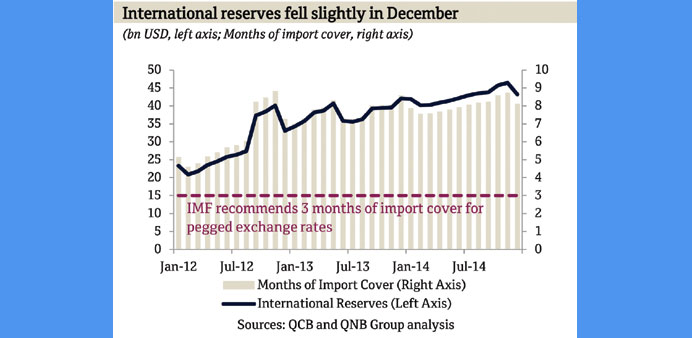
403
Sorry!!
Error! We're sorry, but the page you were looking for doesn't exist.
Qatar's level of foreign reserves 'comfortable'
(MENAFN- Gulf Times) Qatar's import cover stood at 8.1 months in December, well above the IMF-recommended level, a new report has shown.
The International Monetary Fund (IMF) has recommended three months import cover for Qatar for pegged exchange rates, according to QNB.
This denotes comfortable international reserves for Qatar, although these have "fallen slightly" in December compared to the previous month.
Qatar's international reserves stood at $43.2bn in December, 2014 compared with $46.5bn in November, QNB said in its monthly monitor.
More broadly, Qatar's international reserves have been "steadily rising" over the years on large current account surpluses.
Going forward, QNB expects international reserves to rise further on continued current account surpluses.
The report showed that Qatari oil prices continued to decline on weaker global demand although production rose in December.
The stagnant eurozone economy, the recession in Japan and the slowdown in emerging markets, especially China, are contributing to the weakness in hydrocarbon demand and a supply glut, which is putting downward pressure on oil prices.
Qatar's crude oil production rose in December 2014 and redevelopment plans should stabilise output further.
"Qatar Petroleum (QP) is implementing a redevelopment programme to steady production at its oil fields. This heavy investment in existing oilfields should limit further declines in oil production," QNB said.
According to QNB, Qatar's foreign merchandise trade balance registered a surplus of QR22.7bn in December compared with QR33.9bn in December.
This, it said was mainly a result of lower international crude oil prices, which reduced total exports by 21.7%.
At the same time, imports rose strongly (18.3% year-on-year) reflecting the growing population and large investment spending.
Total exports in December stood at QR33.8bn and imports at QR11.1bn.
Japan was the top export destination in December, accounting for 25.6% of Qatar's exports, followed by South Korea (20.3%) and India (12.9%).
The US was the largest exporter to Qatar in December (11.3%), followed by China (10.7%) and Germany (7.5%).
The report highlighted the large influx of expatriates into the country in view of the large ramp up in major project infrastructure spending that are part of Qatar's long term development plans.
"In turn, this larger population is feeding into higher economic growth by boosting aggregate demand and investment in housing and services," QNB said.
Qatar's population grew by 10.3% year-on-year in January 2015 to reach 2.22mn.
This equates to an increase in the population of 208,000 over the last 12 months.
The International Monetary Fund (IMF) has recommended three months import cover for Qatar for pegged exchange rates, according to QNB.
This denotes comfortable international reserves for Qatar, although these have "fallen slightly" in December compared to the previous month.
Qatar's international reserves stood at $43.2bn in December, 2014 compared with $46.5bn in November, QNB said in its monthly monitor.
More broadly, Qatar's international reserves have been "steadily rising" over the years on large current account surpluses.
Going forward, QNB expects international reserves to rise further on continued current account surpluses.
The report showed that Qatari oil prices continued to decline on weaker global demand although production rose in December.
The stagnant eurozone economy, the recession in Japan and the slowdown in emerging markets, especially China, are contributing to the weakness in hydrocarbon demand and a supply glut, which is putting downward pressure on oil prices.
Qatar's crude oil production rose in December 2014 and redevelopment plans should stabilise output further.
"Qatar Petroleum (QP) is implementing a redevelopment programme to steady production at its oil fields. This heavy investment in existing oilfields should limit further declines in oil production," QNB said.
According to QNB, Qatar's foreign merchandise trade balance registered a surplus of QR22.7bn in December compared with QR33.9bn in December.
This, it said was mainly a result of lower international crude oil prices, which reduced total exports by 21.7%.
At the same time, imports rose strongly (18.3% year-on-year) reflecting the growing population and large investment spending.
Total exports in December stood at QR33.8bn and imports at QR11.1bn.
Japan was the top export destination in December, accounting for 25.6% of Qatar's exports, followed by South Korea (20.3%) and India (12.9%).
The US was the largest exporter to Qatar in December (11.3%), followed by China (10.7%) and Germany (7.5%).
The report highlighted the large influx of expatriates into the country in view of the large ramp up in major project infrastructure spending that are part of Qatar's long term development plans.
"In turn, this larger population is feeding into higher economic growth by boosting aggregate demand and investment in housing and services," QNB said.
Qatar's population grew by 10.3% year-on-year in January 2015 to reach 2.22mn.
This equates to an increase in the population of 208,000 over the last 12 months.

Legal Disclaimer:
MENAFN provides the
information “as is” without warranty of any kind. We do not accept
any responsibility or liability for the accuracy, content, images,
videos, licenses, completeness, legality, or reliability of the information
contained in this article. If you have any complaints or copyright
issues related to this article, kindly contact the provider above.


















Comments
No comment